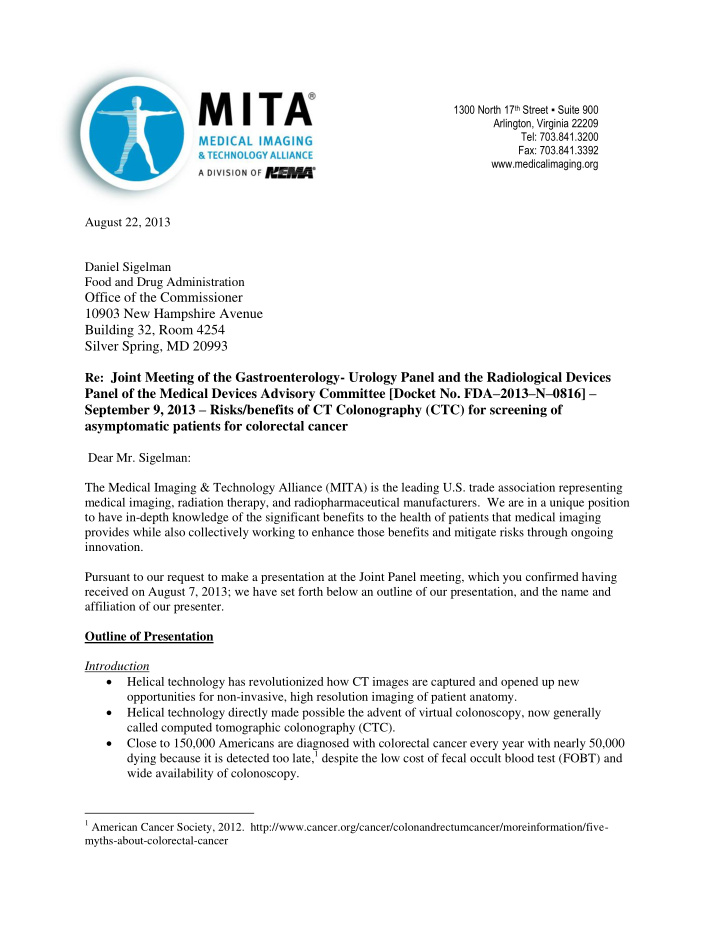



1300 North 17 th Street ▪ Suite 900 Arlington, Virginia 22209 Tel: 703.841.3200 Fax: 703.841.3392 www.medicalimaging.org August 22, 2013 Daniel Sigelman Food and Drug Administration Office of the Commissioner 10903 New Hampshire Avenue Building 32, Room 4254 Silver Spring, MD 20993 Re: Joint Meeting of the Gastroenterology- Urology Panel and the Radiological Devices Panel of the Medical Devices Advisory Committee [Docket No. FDA – 2013 – N – 0816] – September 9, 2013 – Risks/benefits of CT Colonography (CTC) for screening of asymptomatic patients for colorectal cancer Dear Mr. Sigelman: The Medical Imaging & Technology Alliance (MITA) is the leading U.S. trade association representing medical imaging, radiation therapy, and radiopharmaceutical manufacturers. We are in a unique position to have in-depth knowledge of the significant benefits to the health of patients that medical imaging provides while also collectively working to enhance those benefits and mitigate risks through ongoing innovation. Pursuant to our request to make a presentation at the Joint Panel meeting, which you confirmed having received on August 7, 2013; we have set forth below an outline of our presentation, and the name and affiliation of our presenter. Outline of Presentation Introduction Helical technology has revolutionized how CT images are captured and opened up new opportunities for non-invasive, high resolution imaging of patient anatomy. Helical technology directly made possible the advent of virtual colonoscopy, now generally called computed tomographic colonography (CTC). Close to 150,000 Americans are diagnosed with colorectal cancer every year with nearly 50,000 dying because it is detected too late, 1 despite the low cost of fecal occult blood test (FOBT) and wide availability of colonoscopy. 1 American Cancer Society, 2012. http://www.cancer.org/cancer/colonandrectumcancer/moreinformation/five- myths-about-colorectal-cancer
Colorectal cancer is the third most frequently diagnosed cancer and the second leading cause of cancer death in both men and women in the United States. 2 MITA is keenly interested in bringing solutions to bear that can reduce those numbers, and we believe that CTC is clearly one of those solutions. In 2008 the United States Preventive Services Task Force (USPSTF) examined CTC for purposes of screening for colorectal cancer and concluded that the evidence was insufficient at that time to adequately assess the net benefits compared to risks of the procedure. A particular concern was the potential for patient harm from exposure to radiation during the exam. Since that time, the medical imaging community has developed a number of ways to address the issue of radiation dose through new technology, standards, and education. Technology Innovations in CT Systems Automatic Exposure Control helps optimize dose for each patient for the given diagnostic task. Wider coverage detectors minimize the amount of x-ray that falls outside of the active detector region. “Shutter” modes block unused x-ray at the beginning and end of helical scans. First generation CT iterative reconstruction results in a significant (40-50%) dose reduction potential. Second generation CT iterative reconstruction further advanced dose reduction potential with some exams at 1 mSv levels for combined supine and prone CTC scans. DICOM Dose Structured Report allows the exam dose to be electronically captured with the patient record. Standards NEMA XR-25, Computed Tomography Dose Check standard enables setting notification values for each protocol that provides an alert if dose exceeds a user determined threshold. NEMA XR-26, The Access Controls for Computed Tomography: Identification, Interlocks, and Logs requires software features that ensure only an authorized operator can alter the controls of CT equipment. NEMA XR-27, X-ray Equipment for Interventional Procedures User Quality Control Mode standard helps imaging facilities conduct quality testing and monitoring of X-ray equipment used for interventional procedures. NEMA XR-29, Standard Attributes on Computed Tomography (CT) Equipment Related to Dose Optimization and Management, or MITA Smart Dose, is the fourth dose-related standard to be released by MITA since 2010. Education Comprehensive applications training for new CT scanners is provided, and includes robust instruction on how to tailor radiation dose to the lowest level needed to capture diagnostic quality images. Member companies provide educational grants to support a wide variety of CME programs for radiologists/technologists. Programs include optimizing and minimizing dose during CT exams. 2 American Cancer Society. Cancer Facts and Figures, 2012. http://www.cancer.org/acs/groups/content/@epidemiologysurveilance/documents/document/acspc-031941.pdf
Conclusion Since the 2008 USPSTF statement on CTC almost 750,000 people in the United States have been diagnosed with colorectal cancer, and approximately 250,000 people have died from it. MITA believes it is time for CTC to receive mainstream acknowledgement in the medical community as a frontline tool that can provide another diagnostic option for people who are currently resistant to customary colorectal cancer screening modalities and may otherwise avoid colorectal cancer screening altogether. Presenter: Richard A. Frank, MD, PhD Chief Medical Officer Siemens Healthcare Malvern, PA MITA would appreciate the opportunity to present these points at the upcoming meeting. Thank you for considering our request. Sincerely, Gail Rodriguez, Ph.D. Executive Director, MITA
Recommend
More recommend